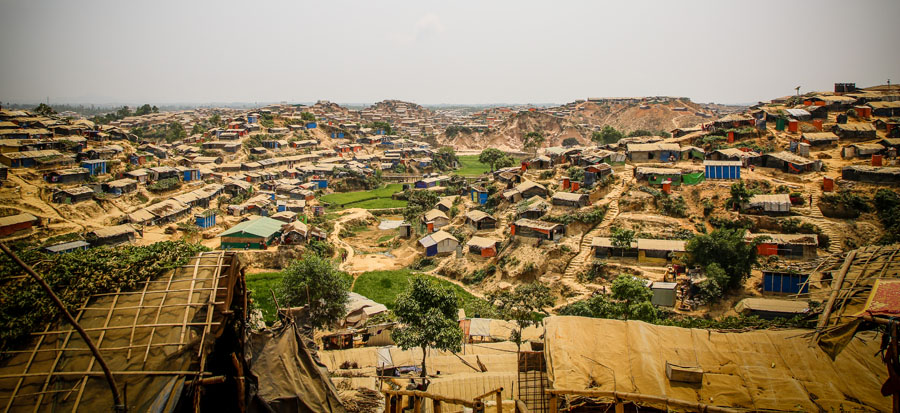BANGLADESH – Over the years, I have been part of projects responding to humanitarian needs in some of the world’s largest refugee camps. Last year, I visited two new refugee camps that are now in this group.
Last year, I visited two new refugee camps that are now in this group.
In 2016 Bidibidi, a refugee camp in northern Uganda, became the world’s newest and fastest growing refugee camp as it provided safety for South Sudanese families escaping conflict. However, in a few short months, the Kutupalong-Balukhali camp, located near Cox’s Bazaar in Bangladesh, became the newest, fastest growing, and largest refugee camp in the world.
Kutupalong-Balukhali currently hosts the stateless Rohingya people who fled their communities in Myanmar following horrific violence and human rights abuses inflicted upon them in August 2017.
World leaders have described the actions against them by Myanmar’s security forces as ethnic cleansing and genocide. There is ample evidence and many eyewitnesses to the killings, robbery, and rape.
Since August, over 670,000 Rohingyas abandoned their homes seeking safety in Bangladesh. Many walked for days, often in the cover of darkness, to escape the attention of armed groups hunting them. Traumatized, hungry, and exhausted, most used whatever means necessary to cross the narrow sea channel to reach safety in neighboring Bangladesh.
I have seen the camps that make up Kutupalong-Balukhali on two separate visits already. The settlement is a de-facto city less than a year old, with a population similar to Seattle or Winnipeg. It stretches out as far as they eye can see – an endless sea of tents and makeshift shelters covering the hillside, sprawling into the horizon. Space is a premium, and even though the United Nations agencies, the Bangladesh government, and other non-governmental agencies including World Renew offer assistance, the level, diversity, and scale of need remains enormous.
Survivors of Violence
Most of the newcomers in Kutupalong-Balukhali are direct or indirect victims of violence. There are countless stories of what occurred. They are horrifying and hard to absorb.
Asima, a girl of 14 (pictured top), lost her father and two siblings. “I used to live in Myanmar. When I came home from school I would go to the vegetable fields to work,” she shares. One day, her brother and father were on the way home when the military shot them both. “When the military saw that they were moving they went up to them and cut their throats. I saw this happen and ran towards them but my mother stopped me because it was not safe. The military came to our house and got my sister, raped and killed her. She was 20 years old and had been married 7 days. Next, the military started opening gunfire on my village. They set our house and our neighbors houses on fire.”
Sadly, her story is not unique. The sheer number of those who experienced or witnessed violence is staggering. One statistic that resonated deeply with me was that 5,600 children are now the lone heads of families because their parents have been killed or are missing. At just 17 years old, Mabia has become the head of her family. When armed men detained her parents, and violence descended upon her village, she and her three younger sisters had no choice but to run. “I’m in charge of the family now and I want to die. The responsibility is beyond me,” she shared despondently. “I want to feed them well, and most of all I don’t want them to remember the bad things that they saw in Myanmar”.
An Uncertain Future
The future is uncertain for the Rohingya living in Bangladesh. They are not permitted to work outside the camp, and there are few options in the camp to work, study or play. While the Bangladesh government provides what it can and gives permission for the Rohingya to stay, it does not have the resources or a long-term plan to integrate the Rohingya people into its society. While leaders talk, the monsoon rains are already coming. Rains bring a new level of risk as thousands of refugees are living in areas at risk of flooding and landslides. With those rains also comes a new season, the arrival of 50,000 new residents – babies born inside the camp.
Nine months ago, violence against Rohingya people reached a peak. Sexual violence against women and girls was prevalent. The victims of rape, at least 13,500 women and girls, have now started giving birth. As these women and girls give birth to babies conceived in rape, they are forced to relive the trauma of their experiences. Many young girls have become child brides to reduce the stigma they and their family face because of pregnancies out of wedlock. Their testimonies are heartbreaking. What is the future for the girls and women who witnessed the killing of their loved ones and experienced horrific violence upon themselves? What is the future for those who are born in the camp, regardless of how they were conceived?
Taking Action
I have no easy answers to ease your mind as you read this.
As followers of Christ, we must weep, pray, and ACT.
If Asima and Mabia were your surviving daughters, what is your hope for them?
World Renew asks for your prayers and financial support as we continue to respond to the needs of the Rohingya.
We are working with our partners in Bangladesh. We have already provided monthly rations to over 58,000 families, totaling 290,000 people.
We are now planning to build 20 community kitchens to offer a safe cooking space for women and their children. It’s a space that they can share to not only cook, but also to support each other.
This project also has immediate environmental benefits, as 500 families will receive propane stoves, replacing the firewood that they work tirelessly to collect or purchase at a high cost. The deforestation around the camp is clearly visible and these kitchens will make a difference. Asima and Mabia are God’s children, no different than yours or mine.
Please join us as we work together with others in extending Christ’s compassion.
Blessings,
Ken Kim
Director
World Renew International Disaster Response & Rehabilitation


